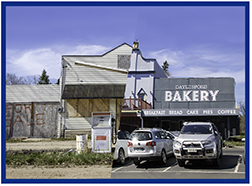SPECIAL FEATURE
Quick Tax Time To-Do
 The end of 2019 is fast approaching and Big "I" Markets will be issuing 1099s soon. Please be sure your agency name, address, tax ID and entity type are updated correctly on your Big "I" Markets profile. The end of 2019 is fast approaching and Big "I" Markets will be issuing 1099s soon. Please be sure your agency name, address, tax ID and entity type are updated correctly on your Big "I" Markets profile.
-
Go to Big "I" Markets at www.bigimarkets.com.
-
Click on the "Register/Update Profile" button.
-
Login with your username and password.
-
Review your agency information for accuracy, then hit "Next."
-
On Step two, confirm your business name, legal status and your tax ID information. In addition, please review your EFT banking information for commission deposits. If not currently registered, please complete that data as well.
-
Once all items are completed, click "Next" to save that data. You can then exit.
View this two-minute video that walks you through the process.
Any questions may be directed to bigimarkets@iiaba.net.
Thank you for being a valued part of Big "I" Markets! Email us with your suggestions.
|
Environmental Indemnity Insurance for Real Estate Title Transfers
Many Agents Miss the Opportunity to Assist Their Clients in Real Estate Deals
 By Brad Maurer, Environmental Insurance Consultant American Risk Management Resources Network, LLC By Brad Maurer, Environmental Insurance Consultant American Risk Management Resources Network, LLC
As insurance professionals, we are constantly balancing the need for client asset protection and the need to keep our client's insurance costs within budget. Insurance is a business necessity, but it is an operational cost that is scrutinized each year. But there are times when insurance becomes an asset to a client. Environmental insurance can help a client sell or purchase real estate with more favorable terms when environmental issues impact the sale price or threaten the ability to close. Informing clients about this product improves agent's position as a trusted risk advisor as well as a business consultant.
Environmental issues with property may be as mundane as an old underground storage tank that may not have been removed properly or as severe as known soil and building contamination from operations that occurred long ago. Perhaps your client wants to move their office into that old brick manufacturing building which is being cleaned up and fitted out into amazing commercial loft space or perhaps your bank client wishes to put a branch on an old gas station property. When these things happen, you client will typically be unaware that there is an insurance solution to the risk that contamination exists or has been cleaned up properly. Clients assume that such issues are uninsurable and rely on attorneys to craft complicated indemnity agreements, establish contingency escrows that ties up funds, offer personal guarantees to lenders or even worse - walk away from a great business opportunity.
Environmental indemnities have become a mainstay component in real estate transactions. Whether seller indemnifies buyer or buyer indemnifies their mortgagee, there is often some contractual risk transfer of liability for the presence of contamination at the transferred property. In recent years, buyers have even indemnified sellers - even when the presence of contamination is known to the parties. Environmental indemnity insurance is making its way into the mainstream of real estate transactions - mainly for commercial and industrial sales, but also for residential developments for two main reasons: 1.) It secures funds for the indemnitor's obligation; and 2.) Its premium expense provides a cost accounting for the value of the indemnity. A third reason is emerging as well - it simplifies the indemnity negotiation process and thereby increases both the likelihood of coming to agreeable terms and closing the transaction.
This is not your typical type of insurance. An insurance broker is essential to its placement and when selecting one, they should have the following qualifications:
-
Product Knowledge. A solid understanding of the coverage and policy forms.
-
Market Knowledge. Up to date awareness of the underwriting markets' appetites and capabilities.
-
Transaction Experience. Experience in insuring real estate transactions.
-
Technical Expertise. Technical understanding of environmental due diligence, environmental laws, and regulations.
If your agency does not have in-house expertise, there are partnering agents and wholesalers that do who can assist you with these placements.
What is Environmental Indemnity Insurance?
Environmental Indemnity Insurance
Environmental Indemnity Insurance is pollution legal liability insurance with added terms and conditions that make it suitable for insuring the environmental risks transferred via an environmental indemnity contract. And while environmental indemnity contracts may be broad or narrow in scope, the pollution legal liability insurance market has come to offer "standard" terms that define its scope and terms.
-
"Pollution Conditions" insured
Pollution legal liability insurance applies to loss arising from pollution conditions. For coverage to apply, the claimed loss must arise from:
Pollution Conditions means the discharge, dispersal, release or escape of any solid, liquid, gaseous or thermal irritant or contaminant, including smoke, vapors, fumes, alkalis, toxic chemicals, medical waste and waste products into or upon land, or any structure on land, the atmosphere or any watercourse or body of water, including groundwater, provided such conditions are not naturally present in the environment.
-
Covered Location(s)
To be covered, pollution conditions must occur on, at or emanating from a covered location. These policies define two types of covered locations:
-
Scheduled Locations. Properties owned or leased by the insured and scheduled onto the policy; and
-
Non-Owned Disposal Locations. Non-owned or leased properties to which the insured transport waste.
-
Types of Covered Claims
Once it is established that pollution conditions have occurred and that the insured's claim for them is first made during the policy period, insurers provide a host of loss coverages that may be purchased individually or together as a whole. For third party liability loss, the insurer also provides defense expense.
Core Coverages:
-
Liability for Bodily Injury
Physical injury, or sickness, disease, mental anguish or emotional distress, sustained by any person, including death resulting therefrom
-
Liability for Property Damage
-
Physical injury to, or destruction of, tangible property of a third-party, including all resulting loss of use of that property;
-
Loss of use of tangible property of a third-party, that is not physically injured or destroyed;
-
Diminished value of tangible property owned by a third-party; or
-
Natural resource damages.
-
Liability for Clean-Up Costs
Expenses incurred to investigate, quantify, monitor, remove, dispose, treat, neutralize, or immobilize pollution conditions or indoor environmental conditions to the extent required by environmental law.
Additional Coverages:
-
Disposal Site Liability
-
Transportation Liability
-
Contractual Liability
-
Business Interruption Expense
-
Reputation Management Expense
Each of these coverages are elective and subject to underwriting.
-
Steps to Acquire Environmental Indemnity Insurance
-
Define the Deal
Is this a standard fee title transfer or lease? Who are the parties? What is the scope of the environmental indemnity? These are questions, among others, that need to be answered so that the proper insurance placement may occur. Key questions are whether the property is to be improved post-closing (e.g. buildings erected, modified or demolished) and whether the use will change.
-
Define Risk Transfer Objectives and Specifications
Buyer, Seller, Mortgagee or tenant may be the insured parties. Identify the terms they require to match the risks to be transferred (e.g. the coverages itemized above which are subject to the indemnity). Determine an amount of transfer (the policy limit) and the term of the insurance (up to 10 years). Other specifications may be necessary if the indemnity encompasses risk that may be excluded or limited on standard environmental insurance forms (e.g. asbestos, lead, legionella, capital improvements).
-
Establish an Underwriting Information Exchange Protocol.
Disclosure. Disclosure. Disclosure. Underwriters should be given every available environmental report that concerns the property. Since transactions involve multiple parties, it is important to designate a point of contact at each and make sure that the representative insurance broker receives from them every available document and remits it to every underwriter considering the deal. An omitted report may be material to the risk and could undermine the policy's validity.
-
Manage the Underwriting
Each underwriter is different in their underwriting approach and each may request a different set of additional inquiries. When one underwriter asks for additional information, it is important that the response be disclosed to all others. When satisfied, underwriters will issue an "indication of coverage". This is an insurance quote that is subject to the receipt of requested information. Most often the underwriters request that their own specific application be submitted for a final quote. It is my practice to use these "indications" to select an underwriter.
-
Select an Underwriter and Hone the Policy Terms
Based upon the indications, select an underwriter whose terms are most reflective of the environmental indemnity and whose premium is in line with the market. Work with the selected underwriter to both satisfy their specific additional information requests as well as your proposed amendments to their policy form to line up the policy with the indemnity to be insured.
-
Place the Policy
Environmental insurance policies for indemnity risk transfer are typically bound on or near closing of the real estate transaction. At this time, the parties will receive the binder and evidence of insurance to finalize their deal. This may mean that the quoted environmental insurance "sits' for a period of time until closing. During this "sitting" time, it is important to communicate to the underwriter anything that may change their approach (e.g. amendments to the indemnity language, additional site work, etc.) and update them on the expected closing date to keep the quote valid.
One could write a book about all of the policy clauses, underwriting approaches, and methods of placing this insurance, but in this limited article I hope I raised some awareness about the value of the product and the important aspects of its placement. ARMR has insured hundreds of transactions and they each seem to have their own unique circumstances, but this summary applies to all of them in terms of coverage available and the means to procure it. ARMR is always happy to answer any questions you may have and may be reached at marketing@armr.net or by phone at 877-735-0800!
[1] These insurance policies are not standard. Each has its own terms, conditions and meanings. Even when an insurer has a standard, pre-printed form it is common for amendments to be made to them. All definitions and terms used here are hybridized from multiple insurers. It is important to carefully read any offered insurance contract for its specific meanings.
|
|
VU Webinars and Lightning Learning
Virtual University
|
WEBINARS - Two-hours with CE in select states.
View the complete calendar, registration links and see what states have CE approval online. Registration includes live webinar, on-demand recording and a transcript.
|
|
|
Prizes will be to the first response with the correct answers and then four selected at random from all received by 6p.m. EDT on Wednesday. Win a $5 gift card (Starbucks, Dunkin' Donuts, Baskin Robbins, or Krispy Kreme).
Don't forget to answer the Tie Breaker!
1. What is the third, emerging reason Environmental Indemnity Insurance is "making its way into the mainstream of real estate transactions" given in the above Pollution article?
2. Egon Ronay had what body part insured for $375,000 in the 1990s?
3. In the Travelers Technology Services flyer linked above, what is the up to limit of the Umbrella over primary coverage?
TIE BREAKER
TB - On this date in 1805 what famous trio reached the Pacific Ocean, a significant milestone of a journey that would eventually be over 8,000 miles?
|
BIG "I" MARKETS SALE OF THE WEEK
|
|
|
|
|
|
 |